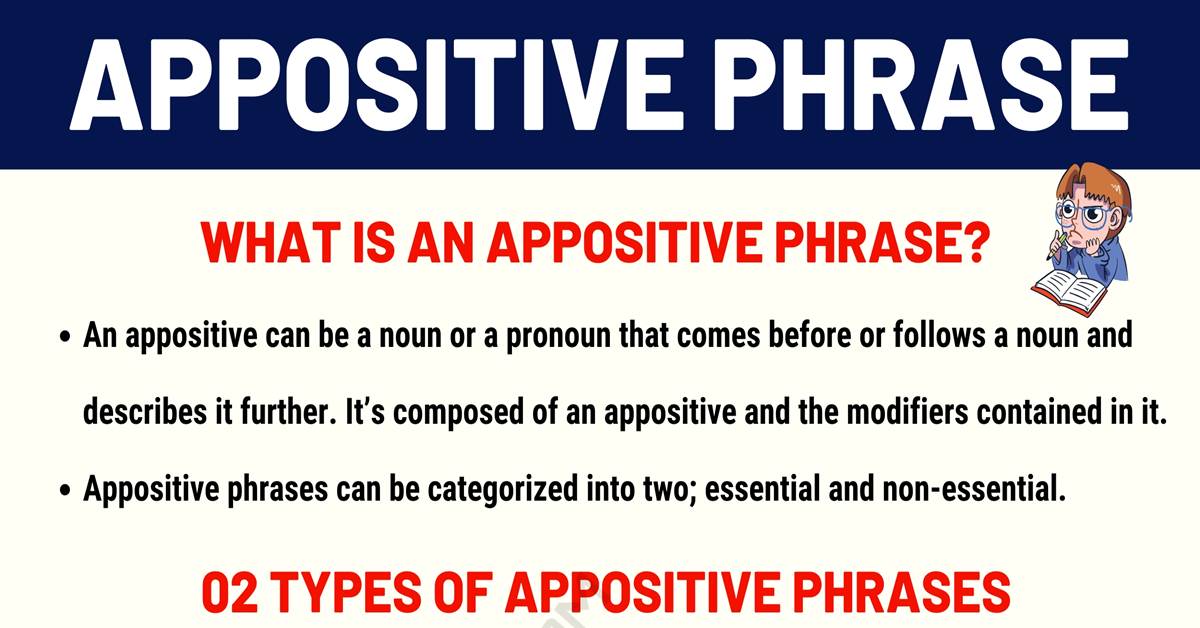What is an appositive phrase? Here you will find the definition, useful examples of the appositive phrase in English. You also learn different forms of appositive phrases with useful example sentences to make your study of grammar much easier.
Appositive Phrase
Appositive Phrase Definition
What Is An Appositive Phrase?
An appositive can be a noun or a pronoun that comes before or follows a noun and describes it further. It’s composed of an appositive and the modifiers contained in it. Appositive phrases can be categorized into two; essential and non-essential.
An essential appositive phrase gives useful information that can be relied upon to identify a noun or pronoun that follows it. An essential appositive phrase adds more information about a noun or pronoun in a sentence making it much more meaningful. A sentence with no essential appositive phrase is not meaningful. Both essential and no essential appositives phrases modify a noun or pronoun, but the only difference is that non-essential appositive phrase gives additional information about a noun or a pronoun that does not add more value to the readers. A non-essential appositive phrase is setup with commas.
Types of Appositive Phrases
Essential Appositive Phrases
Examples of essential appositive phrases in a sentence:
- Artist Willy Paul produced over 20 gospel albums during his career in the music industry.
Here “Willy Paul” is the appositive phrase since it identifies the Artist.
- Attorney David Jacob has represented several States in the United States in legal affairs, including Washington DC.
Here “David Jacob” is the appositive phrase since it identifies the attorney.
- The newspaper The UK Daily Mail was published for the first time in the 1930s.
“The UK Daily Mail” is the appositive phrase since it identifies the newspaper.
- Edward Christopher Sheeran’s song I found a love for me won the top world best love song award 2011.
“I found a love for me” is the appositive phrase since it identifies the song.
- Legend Super Frank Lampard did wonders during his time in Chelsea as a footballer.
The appositive phrase is “Frank Lampard” since it identifies the legend.
Non-essential Appositive Phrases
Examples of non-essential appositive phrases:
- James, the teacher on duty, teaches mathematics.
Here “the teacher on duty” is the appositive phrase since it identifies James.
- During our final match, we sang blue is the color, the Chelsea FCB anthem.
Here the “Chelsea FCB anthem” is the appositive phrase since it identifies blue is the color.
- The Vasco da Gama pillar, a historical monument, was built in the 1500s.
Here the appositive phrase “A historical monument” as it identifies Vasco da Gama Pillar.
- Monaco, a city in France, is known to be the wealthiest place in the world.
Here the appositive phrase is “A city in France” as it identifies Monaco.
How to Use Appositive Phrases
How to use appositive phrases correctly in a sentence?
They are easy to identify and simple to use in sentences. Writers keep on making mistakes when using appositive phrases in their writing. To use these phrases correctly, keep in mind the following things:
- An appositive phrase follows the noun or pronoun it describes
- An appositive phrase can appear at the beginning, middle, or end of a sentence.
- An appositive phrase is not a complete sentence on its own since it doesn’t have a subject nor predicate.
Commas are the main area where people tend to make mistakes when using appositive phrases. There are instances where commas are necessary, while others are not.
A comma is only necessary when the appositive phrase does not provide crucial information in a sentence.
Here is an example:
- The outgoing principal Margret Lennon could become the longest-serving principal in the history of our school.
In the absence of an appositive phrase, the sentence would be, “The outgoing principal could become the longest-serving principal in the history of our school.” In this sentence, we don’t know who the principal is. Since “Margret Lennon” is essential information, there is no need for commas.
Appositive Phrase Infographic









0 Comments